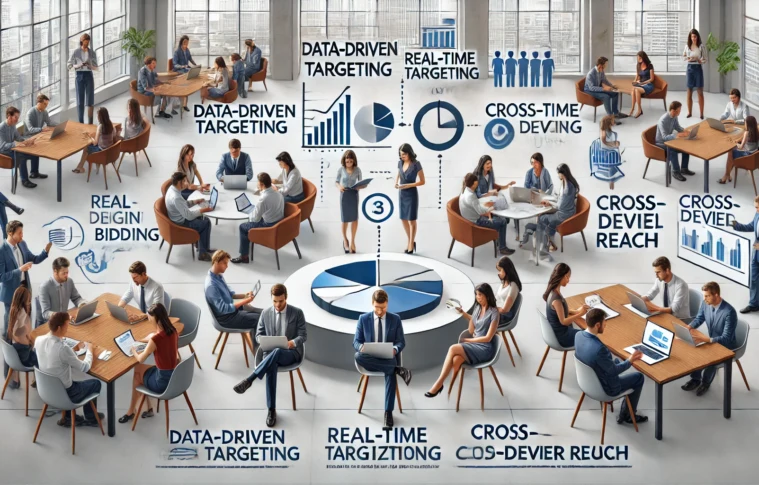Introduction
In today’s fast-paced digital world, traditional methods of buying and selling ads are being replaced by automated, data-driven approaches. Programmatic advertising has become one of the most revolutionary advancements in digital marketing, enabling advertisers to reach their target audience more precisely and efficiently. With digital ad spending growing each year, programmatic advertising is not only a trend but an essential strategy for brands looking to stay competitive.
This blog explores what programmatic advertising is, how it works, its key benefits, and why it is crucial for modern marketing.
What is Programmatic Advertising?
Programmatic advertising is the automated buying and selling of online advertising space, using artificial intelligence (AI) and real-time bidding (RTB) to reach specific audiences. Unlike traditional methods that rely on manual negotiations and placements, programmatic ads leverage algorithms to target audiences based on data, buying ad impressions instantly across multiple platforms.
The programmatic ecosystem includes:
- Demand-Side Platforms (DSPs): Tools that allow advertisers to bid on and purchase ad inventory.
- Supply-Side Platforms (SSPs): Platforms used by publishers to sell ad inventory.
- Data Management Platforms (DMPs): Tools that collect, analyze, and manage audience data for better targeting.
Programmatic advertising offers various formats, including display ads, video ads, native ads, and audio ads, across devices and channels. By optimizing in real time, programmatic advertising helps brands reach the right audience at the right moment with minimal human intervention.
How Programmatic Advertising Works
- Real-Time Bidding (RTB): When a user visits a website, an auction for ad space happens instantly. Advertisers place bids on the impression, and the highest bid wins. This happens within milliseconds, allowing ads to be served seamlessly.
- Data-Driven Targeting: Programmatic ads use audience data—demographics, interests, browsing behavior, and even device type—to ensure that ads are served to users who are likely to be interested. This data-driven approach maximizes relevance and improves ad performance.
- Automated Optimization: Programmatic platforms optimize campaigns in real-time, adjusting bids, targeting parameters, and ad placements based on performance. This ensures that campaigns are always improving and reaching the highest return on ad spend (ROAS).
Benefits of Programmatic Advertising
- Precision Targeting
Programmatic advertising allows marketers to target their audience with remarkable accuracy. By leveraging data from DMPs, advertisers can define target segments based on various criteria such as demographics, location, interests, and even purchase intent. This precision targeting ensures that ads reach the people most likely to convert, reducing wasted impressions and improving ROI.
- Real-Time Optimization
One of the key advantages of programmatic advertising is the ability to optimize campaigns on the fly. Programmatic platforms continuously analyze performance data and make adjustments to improve results. For instance, if a particular audience segment is converting at a higher rate, the platform can automatically allocate more budget to that segment, maximizing effectiveness without manual intervention.
- Cost Efficiency
Programmatic advertising automates the ad buying process, reducing the need for manual negotiations and middlemen. This automation lowers transaction costs, and the real-time bidding model allows advertisers to pay only for impressions that meet their targeting criteria. By reaching the right users at the right time, programmatic ads offer a more cost-effective solution than traditional ad buying methods.
- Cross-Device and Omnichannel Reach
In the current digital landscape, users engage with content across multiple devices and platforms. Programmatic advertising enables brands to reach their audience seamlessly across devices—desktop, mobile, tablet, and even connected TV (CTV). This cross-device reach ensures a cohesive user experience, increasing brand visibility and improving message retention.
- Enhanced Transparency and Control
Programmatic advertising offers advertisers more control over their campaigns, providing insights into where ads are displayed, who views them, and how they perform. Through DSP dashboards, advertisers can track performance metrics in real time, allowing for greater transparency and control. This is particularly valuable in avoiding ad fraud and ensuring brand safety.
Types of Programmatic Advertising
- Open Marketplace (OMP)
This is an open, auction-based marketplace where advertisers bid in real time for available ad inventory. The open marketplace offers a large reach and can be cost-effective, although it comes with limited control over where ads are displayed.
- Private Marketplace (PMP)
Private Marketplaces are invitation-only marketplaces where premium publishers offer ad inventory to select advertisers. PMPs offer a more controlled environment, allowing advertisers to maintain brand safety while accessing high-quality ad placements.
- Programmatic Direct
Programmatic direct allows advertisers to purchase ad inventory directly from publishers, bypassing the auction. This guarantees inventory at a fixed price, providing greater transparency and control. Programmatic direct is ideal for advertisers prioritizing premium placements and consistent visibility.
- Preferred Deals
Preferred deals allow advertisers to negotiate and secure ad inventory at a fixed CPM (cost per thousand impressions) without entering an auction. This method provides more stability than RTB while offering advertisers first access to select inventory before it goes to the open auction.
Why Programmatic Advertising is Essential in Modern Marketing
1. Rising Demand for Personalization
Modern consumers expect relevant, personalized content that aligns with their interests and needs. Programmatic advertising’s data-driven approach makes it possible to deliver personalized ads to specific audience segments, increasing engagement and brand affinity. This level of personalization is nearly impossible to achieve through traditional ad-buying methods.
2. Increased Efficiency and Speed
Programmatic advertising streamlines the process of buying ad space, making it faster and more efficient than traditional methods. Marketers can quickly launch, adjust, and optimize campaigns without lengthy negotiations or manual adjustments. This agility allows brands to stay competitive in rapidly changing markets, adapting to trends and customer behavior in real time.
3. Focus on Outcome-Based Advertising
In the new era of marketing, the focus has shifted from reaching a broad audience to achieving specific outcomes, such as conversions, app installs, or in-store visits. Programmatic platforms offer sophisticated measurement tools, enabling advertisers to track performance against concrete goals. This outcome-based approach allows for more precise ROI tracking and ensures that marketing dollars are spent effectively.
4. Advanced Data Capabilities
Programmatic advertising leverages vast amounts of data to deliver relevant ads. With third-party data sources, machine learning, and AI, programmatic platforms can predict which users are most likely to engage with an ad. This data-centric approach maximizes engagement and optimizes spending, aligning campaigns with business objectives.
5. Future-Readiness
As the advertising industry evolves, programmatic advertising will continue to play a critical role in the future of digital marketing. Innovations like machine learning, AI, and advancements in ad tech will further enhance programmatic capabilities, enabling even more sophisticated targeting, optimization, and measurement. By adopting programmatic strategies today, brands are positioning themselves to capitalize on future developments in digital marketing.
Case Study: Nike’s Programmatic Success
Overview
Nike, a global sports brand, has been a pioneer in leveraging programmatic advertising to reach its audience in a targeted and meaningful way. During a campaign for a new product line, Nike used programmatic to personalize its ads based on user preferences, device type, and location, ensuring a relevant experience for each viewer.
Strategy
- Data-Driven Targeting: Nike used DMP data to identify user segments with a high likelihood of interest in the new product. Ads were tailored based on factors like activity level, location, and preferred devices, creating a more relevant and engaging experience.
- Dynamic Creative Optimization: Programmatic technology enabled Nike to dynamically alter ad creatives based on real-time data. If a user had previously browsed Nike’s website, they received personalized ads showing the specific products they had viewed.
- Cross-Device Reach: Nike’s campaign reached users across desktop, mobile, and connected TVs, ensuring that users encountered Nike’s ads seamlessly, regardless of device. This cross-device approach created a cohesive user experience and reinforced brand messaging.
Results
Nike saw significant results from its programmatic efforts, including a higher engagement rate and increased sales conversions. The precision targeting and dynamic personalization ensured that users received ads that were relevant to them, creating a positive impression and encouraging purchase behavior.
Conclusion
Programmatic advertising has transformed the digital marketing landscape, offering brands an efficient, data-driven way to reach their target audience. With benefits like precise targeting, real-time optimization, cost efficiency, and cross-device reach, programmatic advertising has become essential for modern marketers.
In an era where personalization and efficiency are paramount, programmatic advertising helps brands deliver relevant content to the right users at the right time, maximizing ROI and creating a better experience for consumers. As programmatic technology continues to advance, brands that embrace this approach will be well-positioned to thrive in the digital marketplace.



